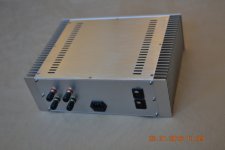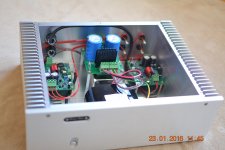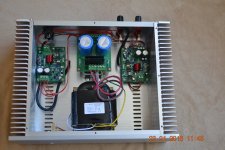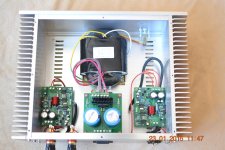Connect the incoming live wire to one switch pair and the incoming neutral wire to the other switch pair. The other end of the pairs go to the power transformer.
Tom
That's what I figured but many thanks for the confirmation - gives me a bit more confidence! I've got some solid core lighting cable (300V 16A rating) which I thought I'd strip and twist the pairs together.
That's what I figured but many thanks for the confirmation - gives me a bit more confidence! I've got some solid core lighting cable (300V 16A rating) which I thought I'd strip and twist the pairs together.
Congrats on your build, it's looking nice 🙂
I had once thought of using that same (or similar) wire (I have a bunch of it). For what it's worth I'll share my opinion: I think that the large gauge, solid core copper wire is not well suited for twisted pairs. Every time you bend it, it gets harder, a little more brittle, and more susceptible to break. It's been more than a few years since I did all the wiring of a bedroom we added onto our house, and honestly I can't remember "everything" that I had to learn during that project (but I must have done something right, passed building code inspection, etc), anyway I seem to remember something about you're not supposed to bend it into a radius of more than (tighter than) certain amount, like 90 degrees IIRC.
I know technically that wire will work. I once thought, heck if it's good enough to feed current up to the mains plug in the wall..... I've since changed my mind though because I realized that for the "application" (inside the amp chassis) I have better wire choices.
Yep, rating is fine, thanks.
More new skills. Had to drill out the holes made for phono plugs to accept XLR sockets. Whoever recommended step drill bits, thanks, a surprisingly easy job as was cutting a thread for the M3 machine screws - another first!

Oh, and despite my concerns about enlarging the hole for the power socket, on proper examination I found it is already equipped with a fuse holder 🙄
That back plate looks clean and sharp.
Thanks Alex, I'll take your comments re internal wiring on board. I was thinking about it last night as I considered crimping the wires to terminals so I could fit and unfit the wires during testing. I can't see crimped terminals would work too well with solid core so maybe I'll go for stranded.
I find that many of my amplifiers do change performance when folded up into a shape to fit an enclosure.
I do use twisted pairs/triplets for ALL my flow and return wires.
This leads me to suspect it is parasitic capacitance that affects performance and maybe a bit of parasitic inductance (less likely).
My most recent build of two NX have a very minor issue with very infrequent oscillation when build as a string on the bench. Vout is usually <0.1mVac
But when assembled into the enclosure, I repeatedly get oscillation that sometimes shuts off the SSR and sometimes just sits there oscillating fortunately with no speaker attached or a "test" speaker that has a 1k0 in the feed. The Vout can be anywhere from 0.0mVac to 0.3mVac
I do use twisted pairs/triplets for ALL my flow and return wires.
This leads me to suspect it is parasitic capacitance that affects performance and maybe a bit of parasitic inductance (less likely).
My most recent build of two NX have a very minor issue with very infrequent oscillation when build as a string on the bench. Vout is usually <0.1mVac
But when assembled into the enclosure, I repeatedly get oscillation that sometimes shuts off the SSR and sometimes just sits there oscillating fortunately with no speaker attached or a "test" speaker that has a 1k0 in the feed. The Vout can be anywhere from 0.0mVac to 0.3mVac
I find that many of my amplifiers do change performance when folded up into a shape to fit an enclosure.
Can you share some data on this? As in measured parameters before/after the folding?
My most recent build of two NX have a very minor issue with very infrequent oscillation when build as a string on the bench. Vout is usually <0.1mVac
But when assembled into the enclosure, I repeatedly get oscillation that sometimes shuts off the SSR and sometimes just sits there oscillating fortunately with no speaker attached or a "test" speaker that has a 1k0 in the feed. The Vout can be anywhere from 0.0mVac to 0.3mVac
SSR? I'd like to buy a vowel, please.
There shouldn't be any oscillation at all. None. If you are having trouble with amplifiers that oscillate in one physical configuration but not in another, I suggest looking at supply decoupling. If you're talking about a point-to-point build, you likely goofed somewhere in the feedback path.
The Modulus-86 and Parallel-86 both have significant on-board decoupling capacitance as well as various compensation networks to ensure stability into any reasonable (and some unreasonable) loads. They are stable at load capacitances up to 2.2 uF (in parallel with 8 Ω). Many of the LM3886 amps available can only drive a few tens of nF, if that.
The Modulus-86 and Parallel-86 (and any other amplifier I may design) are well designed, well prototyped, well tested, and well documented products. That's my value-add, basically.
There are amplifier circuits and kits out there that are pretty decent, but also some that are utter crap. Circuits of the latter category will exhibit the oddities you describe. Oscillation if wires get too long or if oriented a certain way, etc. They will require some redesign to get to work well - or some voodoo to get to work half-decent in one configuration. Please don't generalize this to mean that all amplifiers behave in this way.
If you assemble any of my products according to the project documentation, you will get stellar performance. All the data I have shared are measured on actual circuits built according to the instructions. I set people up for success. That's how I operate... 🙂
Tom
.............. The Vout can be anywhere from 0.0mVac to 0.3mVac
The previous para to your question.Can you share some data on this? As in measured parameters before/after the folding?...............
At which frequency? Measurement bandwidth? Spectrum of measured signal?
I did read your post, but it provided no meaningful data to assist me in understanding what you're measuring. You also forgot to define "SSR".
I maintain that a well-designed amp doesn't require any special sauce or voodoo in the assembly.
Tom
I did read your post, but it provided no meaningful data to assist me in understanding what you're measuring. You also forgot to define "SSR".
I maintain that a well-designed amp doesn't require any special sauce or voodoo in the assembly.
Tom
Last edited:
I've just finished my Mod-86 build and I am more than pleased to share it with all my friends here.
The case I used is BZ3612A. It has a perfect size. The heatsinks are cold to touch when music is played at my favorite level. I used THAT 1206 to avoid excessive overall gain and it works beautifully.
I added a two-stage EMI filter to clean AC and I ordered a 200W 22v x 2 R-core transformer from China. It was custom made for me for this amp.
I'd like to thank Tom for designing the great Modulus-86. The DC offset is 4mv at power on and it goes down to 0.0mv in less than 5 seconds. There are no speaker thumps at power on or shut down. The amp is dead silent, silky smooth and transparent. Listening to music puts a big smile on my face and it keeps reminding me of what an excellent job Tom has done for all of us!
Cheers to all🙂
pakultra
The case I used is BZ3612A. It has a perfect size. The heatsinks are cold to touch when music is played at my favorite level. I used THAT 1206 to avoid excessive overall gain and it works beautifully.
I added a two-stage EMI filter to clean AC and I ordered a 200W 22v x 2 R-core transformer from China. It was custom made for me for this amp.
I'd like to thank Tom for designing the great Modulus-86. The DC offset is 4mv at power on and it goes down to 0.0mv in less than 5 seconds. There are no speaker thumps at power on or shut down. The amp is dead silent, silky smooth and transparent. Listening to music puts a big smile on my face and it keeps reminding me of what an excellent job Tom has done for all of us!
Cheers to all🙂
pakultra
Attachments
Hidy,
Nice build, neat job!
Similar experience with the amp - sounds very good to me. 😀
Btw, did you try listening w/o the EMI filter? Were you getting AC line noise?
Nice build, neat job!
Similar experience with the amp - sounds very good to me. 😀
Btw, did you try listening w/o the EMI filter? Were you getting AC line noise?
Last edited:
R-core, very nice. I imagine that broke in to the triple digits after shipping for the transformer alone. I've seen those speaker posts before and would probably use them on my next build. Are those spades 1/4"?
Edit: BTW, I like how you mounted the PS board over the EMI filter(s) to save real estate.
Edit: BTW, I like how you mounted the PS board over the EMI filter(s) to save real estate.
Thanks zman01, I did not try disconnecting the EMI filter. I have a plasma TV that generates a lot of noises to my AC line. My experience with my previous amps and dacs tells me that when the TV is off, there won't be any need for additional EMI filtering. But once I turn on my TV, I will need to take extra measures to ensure the my sound doesn't degrade as much. The degradation is not perceivable by listening, but it shows up in all my measured test results
So I've made it a standard practice for me to add EMI filtering to all my dacs and amps. Mod-86 amp probably won't need additional EMI filtering, but I'd rather over-build where I can afford. It is only an extra $30 dollars for a good 2-stage filter.
So I've made it a standard practice for me to add EMI filtering to all my dacs and amps. Mod-86 amp probably won't need additional EMI filtering, but I'd rather over-build where I can afford. It is only an extra $30 dollars for a good 2-stage filter.
R-core, very nice. I imagine that broke in to the triple digits after shipping for the transformer alone. I've seen those speaker posts before and would probably use them on my next build. Are those spades 1/4"?
Edit: BTW, I like how you mounted the PS board over the EMI filter(s) to save real estate.
Thanks 12B4A, the R-core and the case did cost a lot to ship from China. The R-core alone weighs about 2kg. But I am not particularly impressed with the one I received - to my surprise, it produces a very slight hum that is audible when I have my ear pressed again my case cover. Maybe there is DC in my AC line, but I don't know how to verify that. My other three 30 w R-cores that I use in my DAC are dead silent. Next time, I might try O-core.
The speaker posts are special light-mass pure copper posts that accept both banana plugs and spades. Their model number is EZ-301.
I bought them from Taobao:
EIZZ???????????EZ-301??????????????-??????
Thanks 12B4A, the R-core and the case did cost a lot to ship from China. The R-core alone weighs about 2kg. But I am not particularly impressed with the one I received - to my surprise, it produces a very slight hum that is audible when I have my ear pressed again my case cover. Maybe there is DC in my AC line, but I don't know how to verify that. My other three 30 w R-cores that I use in my DAC are dead silent. Next time, I might try O-core.
The speaker posts are special light-mass pure copper posts that accept both banana plugs and spades. Their model number is EZ-301.
I bought them from Taobao:
EIZZ???????????EZ-301??????????????-??????
Yep, the EZ-301. That's the first site I've seen that has the actual mechanical drawings for it. Unfortunately, I can't see where it says how wide the connector blade is for inside the chassis. It seems likely it is a 1/4 inch.
That's too bad about the r-core. They are distinctive when you happen to see one in a project.
I've just finished my Mod-86 build and I am more than pleased to share it with all my friends here.
Dang! I like it.
I'd like to thank Tom for designing the great Modulus-86. The DC offset is 4mv at power on and it goes down to 0.0mv in less than 5 seconds. There are no speaker thumps at power on or shut down. The amp is dead silent, silky smooth and transparent. Listening to music puts a big smile on my face and it keeps reminding me of what an excellent job Tom has done for all of us!
Awesome. Thank you for sharing. I'm glad you like it. It's these success stories that keep me going.

Tom
I can't see where it says how wide the connector blade is for inside the chassis.
Hi 12B4A, I measured it for you. The connector blade inside the chassis is 6.60 mm (wide) x 1 mm (thick). It does look like it will fit a 1/4 inch spade connector. I never thought about using a spade connector because I don't have any, but it is actually a pretty good idea to use spade to avoid soldering. The speaker posts are coated with gold, so it should work very well with a gold coated copper spade or with good crimping.
What spade connector do you have in mind? I might use such a spade in future🙂
The speaker posts are coated with gold, so it should work very well with a gold coated copper spade or with good crimping.
As long as the spade doesn't just scrape off the gold. Gold is known for being nearly impossible to get to stick to anything. Probably because it doesn't have space in the valence band for more electrons.
I'd just solder to the connectors. That would make one connection. With the spades, you'd have two connections (wire - spade - connector).
Tom
I'd just solder to the connectors. That would make one connection. With the spades, you'd have two connections (wire - spade - connector).
Tom
Right. I am glad I soldered them. I forgot about the extra wire - spade connection.
- Home
- Amplifiers
- Chip Amps
- Modulus-86 build thread






